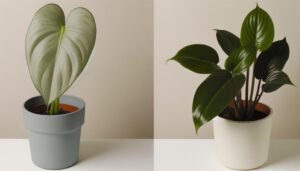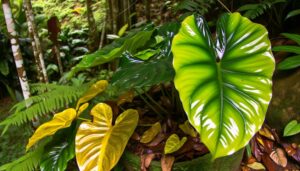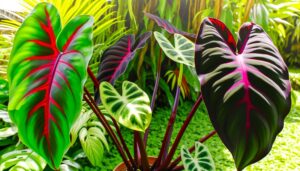Philodendron Cordatum Vs Pothos: Ultimate Comparison Guide!
Philodendron cordatum, from Brazil’s tropical rainforests, and Pothos (Epipremnum aureum) from the Solomon Islands, are two notable members of the Araceae family. Distinguished by their foliage, Philodendron cordatum showcases smooth, velvety heart-shaped leaves, while Pothos features thicker, waxy, ovate leaves.
Both exhibit climbing and trailing growth habits through aerial roots and nodes. Light and water requirements vary slightly, with Philodendron preferring constant moisture and Pothos needing to dry out between waterings.
Soil composition also differs; Philodendron thrives in well-aerated, moisture-retentive soils, whereas Pothos prefers well-draining substrates. Explore further to uncover their unique care distinctions.
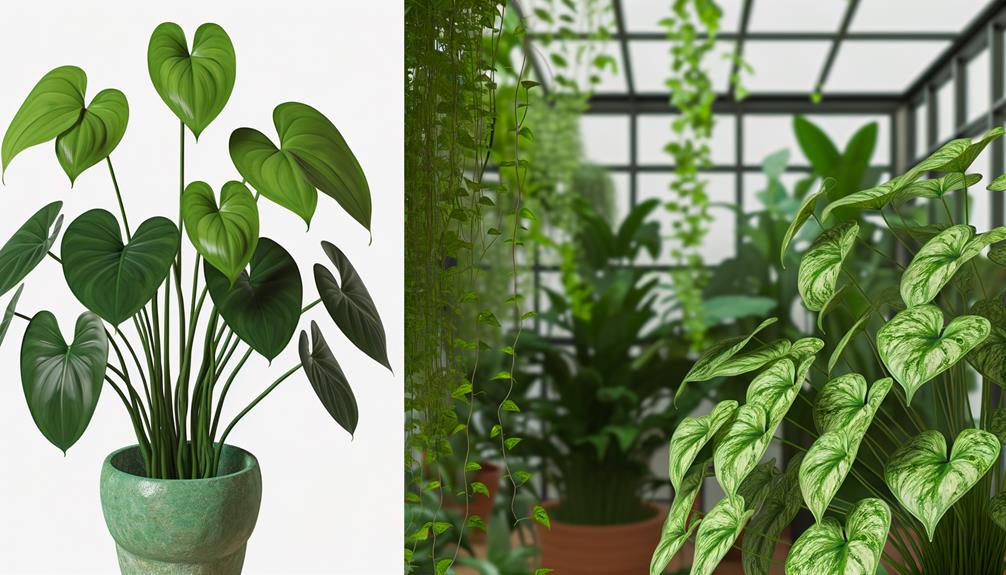
Comparison of Philodendron Cordatum and Pothos
| Feature | Philodendron Cordatum | Pothos |
|---|---|---|
| Scientific Name | Philodendron hederaceum | Epipremnum aureum |
| Leaf Texture | Glossy | Thicker, waxy |
| Leaf Color | Green | Green, often variegated with white, yellow, or light green |
| Leaf Shape | Heart-shaped with a more pronounced curve at the base | Heart-shaped with a straighter base |
| Growth Habit | Climbing/trailing | Climbing/trailing |
| Petioles | Rounded | Indented, curved inward like a celery stalk |
| Aerial Roots | Several smaller roots per node | One large root per node |
| New Leaf Growth | Encased in cataphylls, which dry up and fall off | Tightly curled, unfurls over time |
| Light Tolerance | Better in low light | Prefers bright, indirect light but can tolerate low light |
| Temperature Tolerance | Moderate | Prefers slightly higher temperatures |
| Drought Tolerance | Moderate | More tolerant of drought conditions |
Plant Origins

Philodendron cordatum, a member of the Araceae family, is native to the tropical rainforests of Brazil, whereas Pothos, scientifically known as Epipremnum aureum, originates from the Solomon Islands in the South Pacific.
Philodendron cordatum thrives in the humid, shaded understory of Brazil’s dense rainforests, where it climbs trees using its aerial roots. This environment provides prime conditions for its growth and development.
In contrast, Epipremnum aureum is adapted to the tropical climates of the Solomon Islands, where it can be found both in the wild and as an invasive species in various regions. It exhibits a remarkable resilience, flourishing in a variety of environmental conditions.
Understanding these origins is key to appreciating their unique ecological adaptations and horticultural requirements.
Leaf Characteristics
In examining the leaf characteristics of Philodendron cordatum and Epipremnum aureum (commonly known as Pothos), several distinguishing features emerge.
The leaf shape of Philodendron cordatum typically presents a heart-like form, whereas Pothos exhibits more elongated, ovate leaves.
Additionally, the texture, feel, and color variations between the two species display significant botanical differences that merit detailed exploration.
Leaf Shape Comparison
When comparing the leaf shape of Philodendron cordatum and Pothos, one can observe distinct morphological differences that are essential for accurate identification.
Philodendron cordatum typically exhibits cordate, or heart-shaped, leaves with a pronounced sinus at the leaf base, contributing to its botanical name. These leaves generally possess a more elongated, tapered apex and a smoother margin.
In contrast, Pothos, classified under the genus Epipremnum, showcases ovate to elliptic leaves that are broader and more robust. The leaf apex of Pothos is less tapered, often presenting a more rounded appearance. Additionally, Pothos leaves frequently exhibit slight undulations along the margin, adding to their distinctive texture.
Understanding these variances in leaf morphology aids in the precise differentiation between these two popular houseplants.
Texture and Feel
A key distinction in leaf characteristics between Philodendron cordatum and Pothos lies in their texture and tactile feel, which can be discerned through careful examination.
Philodendron cordatum, a member of the Araceae family, exhibits leaves that are generally smooth and velvety, with a subtle, almost soft touch. This is due to the fine pubescence on the leaf surface.
In contrast, Pothos (Epipremnum aureum), also within the Araceae family, possesses leaves that are thicker and waxier, offering a more robust and slightly coarse texture. The epidermal cells of Pothos are more rigid, contributing to its glossy surface.
These textural differences not only affect their visual appeal but also influence their adaptability to varying humidity levels within indoor environments.
Color Variations
Philodendron cordatum and Pothos display a fascinating array of color variations in their leaves, reflecting their unique genetic traits and environmental adaptations.
Philodendron cordatum typically exhibits heart-shaped leaves in a range of green hues, from deep emerald to lighter, almost lime shades. Some cultivars feature variegation with creamy white or yellow patches.
Conversely, Pothos (Epipremnum aureum) showcases a broader spectrum, including golden-yellow, neon green, and variegated forms with marbled patterns of white or yellow. The variegation in Pothos is often more pronounced, attributed to chimeric mutations and selective breeding.
These chromatic differences not only enhance aesthetic appeal but also indicate varying levels of chlorophyll, impacting photosynthetic efficiency and adaptation to light conditions.
Growth Habits
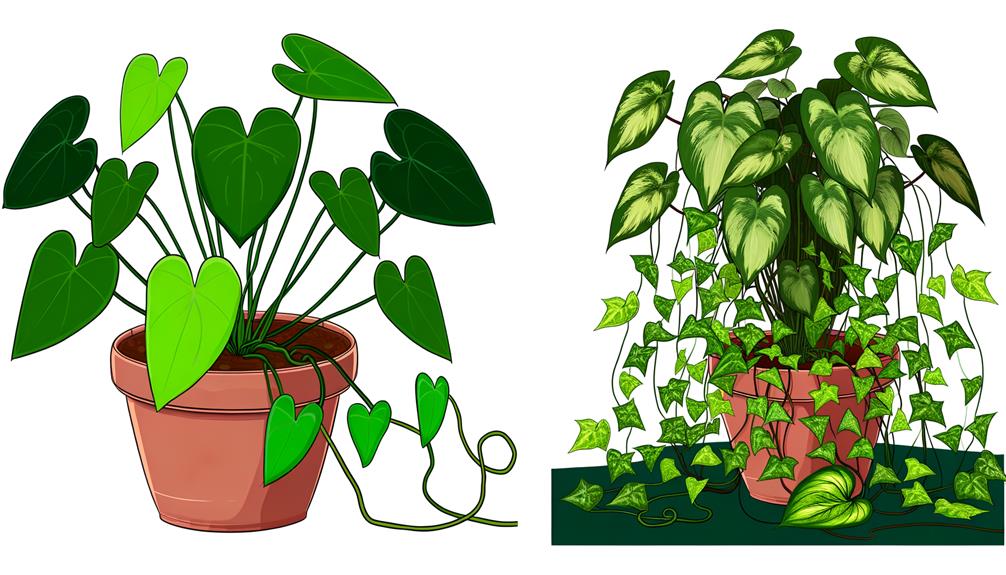
Both Philodendron cordatum and Pothos exhibit vigorous climbing and trailing growth habits, facilitated by their aerial roots and vining stems. Philodendron cordatum, belonging to the Araceae family, uses its adventitious roots to anchor itself, allowing it to scale various surfaces. Its growth pattern is typically more delicate and less aggressive than Pothos.
Conversely, Pothos (Epipremnum aureum) also part of the Araceae family, demonstrates robust growth, often outpacing Philodendron cordatum. Pothos vines can extend several feet, rapidly covering walls or trellises. Both species possess nodes along their stems that produce roots when in contact with suitable support structures.
These adaptive traits enable them to thrive in a variety of environments, making them popular choices for decorative indoor foliage.
Light Requirements
Given their vigorous growth habits, understanding the light requirements of Philodendron cordatum and Pothos is pivotal to optimizing their health and aesthetic appeal.
Philodendron cordatum, belonging to the Araceae family, thrives in bright, indirect light but can tolerate lower light conditions. Excessive direct sunlight may scorch its delicate, heart-shaped leaves, leading to chlorosis.
Conversely, Pothos (Epipremnum aureum), also from the Araceae family, exhibits remarkable adaptability. It prospers in a range of lighting conditions from low to bright, indirect light. However, variegated varieties require more light to maintain their vibrant patterns. Insufficient light may result in the loss of variegation and slower growth.
Both species benefit from filtered light, mimicking their native understory tropical environments.
Watering Needs
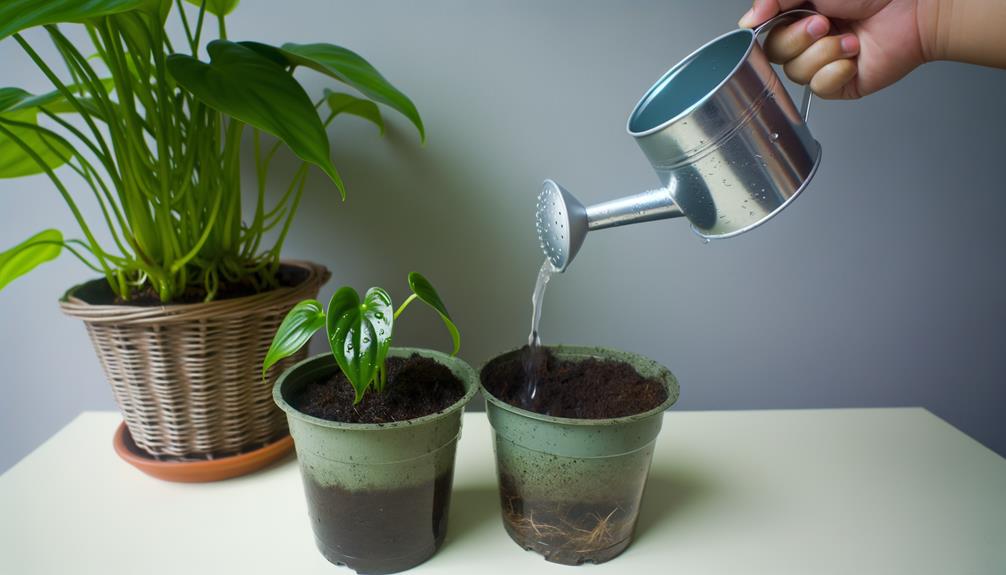
Understanding the watering needs of Philodendron cordatum and Pothos is crucial for preventing root rot and ensuring robust growth.
Philodendron cordatum, belonging to the Araceae family, thrives with consistent moisture but dislikes waterlogged conditions. It is crucial to allow the top inch of soil to dry out between waterings to maintain a balanced equilibrium.
Conversely, Pothos, scientifically known as Epipremnum aureum, exhibits greater tolerance to drought conditions. This member of the Araceae family prefers the soil to dry out more thoroughly between waterings, which reduces the risk of fungal infections.
Both species benefit from well-draining substrates to facilitate proper aeration and moisture management. Regular monitoring and adjusting watering schedules according to environmental conditions are essential for their health.
Soil Preferences
When examining the soil preferences of Philodendron cordatum and Epipremnum aureum (Pothos), it is essential to take into account their drainage and aeration needs, soil moisture levels, and nutrient requirements.
Philodendron cordatum, a member of the Araceae family, thrives in well-draining, aerated soil that retains moderate moisture, whereas Pothos, also from the Araceae family, prefers a similar soil composition but can tolerate a slightly broader range of soil conditions.
Both species benefit from nutrient-rich substrates to support their vigorous growth and foliage development.
Drainage and Aeration Needs
How do the distinct soil preferences for drainage and aeration impact the growth and health of Philodendron cordatum and Pothos?
Philodendron cordatum, belonging to the Araceae family, thrives in well-aerated soil that allows roots to breathe, reducing pathogen susceptibility. They prefer a mix with perlite or orchid bark, ensuring excellent drainage.
In contrast, Pothos (Epipremnum aureum), also from the Araceae family, requires soil with superior drainage but slightly less aeration compared to Philodendron cordatum. A blend of potting soil with added perlite suffices.
Improper drainage can lead to root rot in both species, underscoring the necessity of appropriate soil composition. Understanding these specific requirements is crucial for fostering robust growth and maintaining plant health.
Soil Moisture Levels
Proper soil composition plays a pivotal role in managing soil moisture levels, which are critical for the best growth and health of Philodendron cordatum and Pothos.
Philodendron cordatum, belonging to the Araceae family, thrives in a well-aerated, loose potting mix that retains moisture yet allows excess water to drain efficiently. This balance prevents root rot while maintaining sufficient hydration.
Conversely, Epipremnum aureum, commonly known as Pothos, prefers a slightly less moisture-retentive medium, emphasizing the need for periodic drying between waterings. Its peak growth is achieved in a blend of peat moss and perlite, which ensures proper drainage and aeration.
Understanding these nuanced soil moisture requirements is essential for cultivating healthy, robust specimens of both plant taxa.
Nutrient Requirements
Ensuring ideal nutrient levels in the soil is key for meeting the specific nutritional needs of Philodendron cordatum and Pothos, both of which benefit from a balanced, nutrient-rich substrate.
Philodendron cordatum thrives in well-draining soil with high organic matter, preferring a mix that includes peat moss, perlite, and pine bark. This composition enhances aeration and moisture retention.
Conversely, Pothos (Epipremnum aureum) favors a slightly more forgiving potting mix, comprising peat, coconut coir, and vermiculite, which provides adequate drainage and nutrient availability.
Both species benefit from regular feeding with a balanced, water-soluble fertilizer during the growing season. However, caution must be exercised to avoid over-fertilization, which can lead to nutrient burn and impaired growth.
Common Pests and Problems
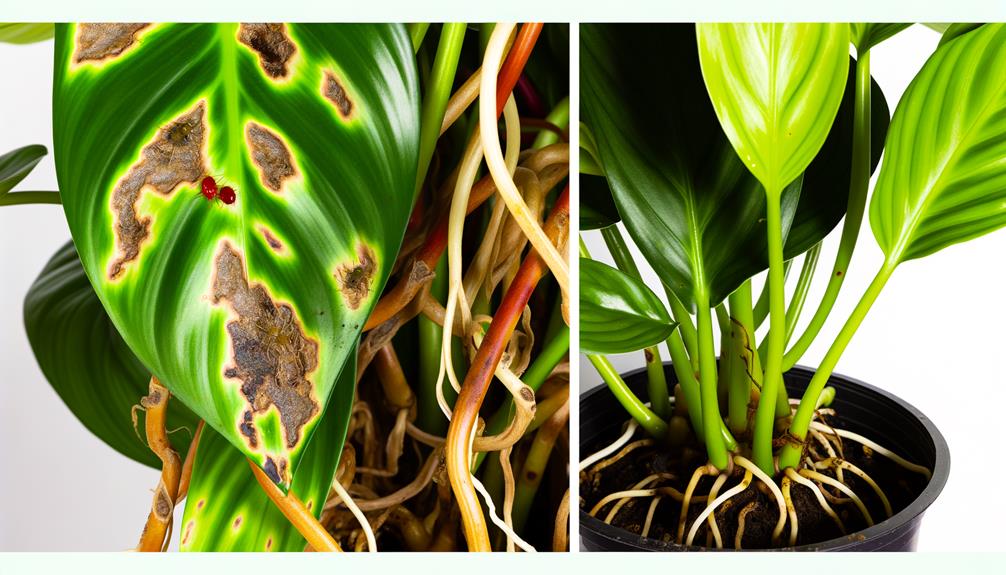
Both Philodendron cordatum and Pothos are susceptible to common pests such as spider mites, aphids, mealybugs, and scale insects, which can cause significant damage to their foliage and overall health.
- Spider mites (Tetranychidae) thrive in dry environments and create webbing on the leaves.
- Aphids (Aphidoidea) feed on plant sap, causing yellowing and stunted growth.
- Mealybugs (Pseudococcidae) appear as white, cotton-like masses and weaken plants by sucking sap.
- Scale insects (Coccoidea) form protective shells and drain essential nutrients.
Regular inspection and prompt treatment with insecticidal soap or neem oil can mitigate these issues. Ensuring adequate humidity and proper plant care also helps prevent pest infestations, promoting healthier growth for both species.
Conclusion
To sum up, while Philodendron cordatum and Pothos may appear deceptively similar to the untrained eye, their distinct botanical characteristics and growth requirements set them apart.
The former, with its heart-shaped leaves and preference for consistent moisture, contrasts sharply with the latter’s robust adaptability and tolerance for neglect.
It seems that in the grand theater of houseplants, one must choose between the cordatum’s delicate demands and the pothos’ resilient demeanor, a decision surely fraught with horticultural significance.



